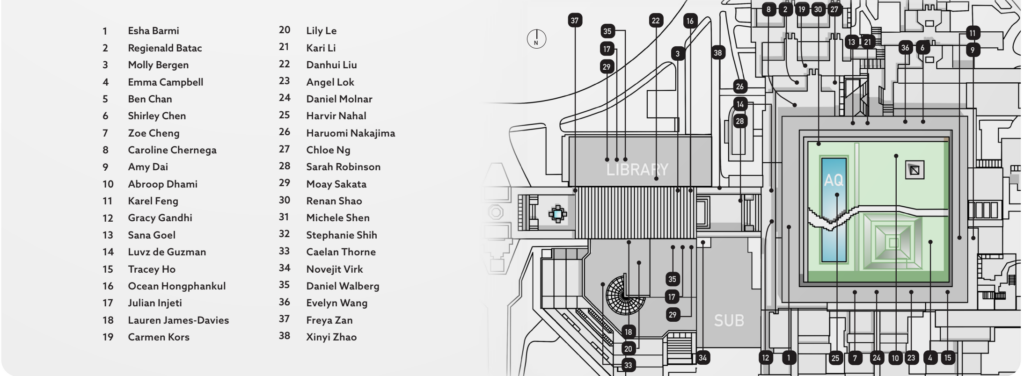By: Sara Wong, Arts & Culture Editor
SFU Burnaby’s aesthetic leaves little to be desired. But thanks to this semester’s CA161 class, taught by Sabine Bitter, the campus will be revitalized with interactive art installations. From collages to conceptual sculptures, the work of these visual arts students aims to highlight the relationship between the public and public art. The Peak spoke with four of the artists to learn more about what this entails and where they drew inspiration from.
These and the rest of CA161 class installations will be around SFU Burnaby from now until April 4. See map below.
Zoe Cheng
Contemporary art galleries can sometimes feel pretentious. Cheng explained some of this disconnect can come from artists making pieces to achieve a level of “sophistication.” According to Cheng, “When the artists say, ‘Oh yes, my art is for the people,’ yet they create something that’s so hard to reach for people, it kills off the purpose.” This is exactly what they want to critique with their sculptural piece, which will be located outside the SFU Gallery. Consisting of multiple plaques and other signs, Cheng is directly questioning the practices of public art institutions by looking at how they present certain artworks.
Creating such a site-specific piece was something Cheng found daunting at first. Elaborating on site-specificity, they explained how integral location is when contextualizing art. If it “doesn’t match the aura, or doesn’t match the purpose of the piece, it causes a schism.” Nevertheless, Cheng said they were happy to push themself and their creative limits, adding they were “extremely grateful for Sabine” and the guidance she provided.
Sana Goel
After observing the amount of movement on campus, particularly in the AQ, Goel wanted her project to echo that — literally. “What I hope to do is have a motion sensor that, when people pass by, it plays the sound of a heartbeat,” she said. The motion sensor will be placed behind a mirror already installed on the AQ’s main floor. Goel hopes students passing by will stop in front of the mirror and “see themselves as the heart of the university.”
Incorporating sonic elements into art can be challenging, but Goel was excited to do so. “You have to be really willing to open your mind to lots of different perspectives when you’re making art,” she said. “Coming into SFU, this was the first opportunity I got to make art and really showcase it. So the fact that I’m getting to showcase it in a place such as the Burnaby campus is a really big deal for me.”
Julian Injeti
With this piece, viewers will have the opportunity to directly interact with the artist. Injeti, being unfamiliar with the Burnaby campus, wanted to use this opportunity to learn from other students. His work was inspired by tabula rasa, a philosophical idea that knowledge comes simply from experience. “I believe conversation is a very powerful thing,” Injeti said. The installation will have a backdrop with thoughts and messages — provided by friends — about SFU Burnaby. Meanwhile, Injeti will be in front of the frame, interviewing students.
However, describing himself as an introvert, Injeti noted this project was out of his comfort zone. “But at the same time, this is one of the few things where I’m excited to be challenged,” he said. Injeti credits CA161 for helping him grow as an artist, summarizing his main takeaways as adaptation, acceptance, and confidence in his craft.
Lauren James-Davies
Combining James-Davies’ interest in history with her artistic practices, this life-sized installation commemorates the Vancouver Women’s Caucus, an SFU organization founded in 1968 to fight for accessible birth control, childcare services, and other feminist policies. Four figures from the caucus, made out of paper, will be featured. “I’m using old photographs of them [ . . . ] and then on top of that, I’m going to be collaging some of the old newspapers that they used to make called The Pedestal,” James-Davies said.
The piece will be featured on the front doors of Maggie Benston Centre — a fitting place considering Benston was co-founder of the Vancouver Women’s Caucus. James-Davies shared this will be her first showcase in a public space. Though the process involved “a lot of experimenting,” she is proud of the final result. Further discussing her figures, James-Davies said, “They’re going to be double sided, so people are going to have to see them.”





